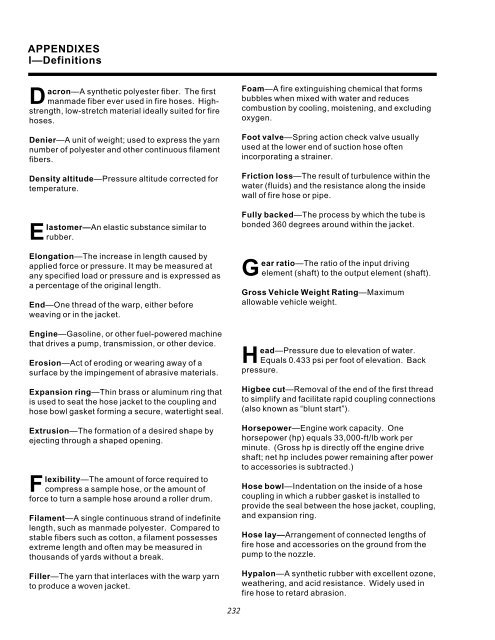Water Handling Equipment Guide - National Wildfire Coordinating ...
Water Handling Equipment Guide - National Wildfire Coordinating ...
Water Handling Equipment Guide - National Wildfire Coordinating ...
Create successful ePaper yourself
Turn your PDF publications into a flip-book with our unique Google optimized e-Paper software.
APPENDIXES<br />
I—Definitions<br />
Dacron—A synthetic polyester fiber. The first<br />
manmade fiber ever used in fire hoses. Highstrength,<br />
low-stretch material ideally suited for fire<br />
hoses.<br />
Denier—A unit of weight; used to express the yarn<br />
number of polyester and other continuous filament<br />
fibers.<br />
Density altitude—Pressure altitude corrected for<br />
temperature.<br />
Elastomer—An elastic substance similar to<br />
rubber.<br />
Elongation—The increase in length caused by<br />
applied force or pressure. It may be measured at<br />
any specified load or pressure and is expressed as<br />
a percentage of the original length.<br />
End—One thread of the warp, either before<br />
weaving or in the jacket.<br />
Engine—Gasoline, or other fuel-powered machine<br />
that drives a pump, transmission, or other device.<br />
Erosion—Act of eroding or wearing away of a<br />
surface by the impingement of abrasive materials.<br />
Expansion ring—Thin brass or aluminum ring that<br />
is used to seat the hose jacket to the coupling and<br />
hose bowl gasket forming a secure, watertight seal.<br />
Extrusion—The formation of a desired shape by<br />
ejecting through a shaped opening.<br />
Flexibility—The amount of force required to<br />
compress a sample hose, or the amount of<br />
force to turn a sample hose around a roller drum.<br />
Filament—A single continuous strand of indefinite<br />
length, such as manmade polyester. Compared to<br />
stable fibers such as cotton, a filament possesses<br />
extreme length and often may be measured in<br />
thousands of yards without a break.<br />
Filler—The yarn that interlaces with the warp yarn<br />
to produce a woven jacket.<br />
Foam—A fire extinguishing chemical that forms<br />
bubbles when mixed with water and reduces<br />
combustion by cooling, moistening, and excluding<br />
oxygen.<br />
Foot valve—Spring action check valve usually<br />
used at the lower end of suction hose often<br />
incorporating a strainer.<br />
Friction loss—The result of turbulence within the<br />
water (fluids) and the resistance along the inside<br />
wall of fire hose or pipe.<br />
Fully backed—The process by which the tube is<br />
bonded 360 degrees around within the jacket.<br />
Gear ratio—The ratio of the input driving<br />
element (shaft) to the output element (shaft).<br />
Gross Vehicle Weight Rating—Maximum<br />
allowable vehicle weight.<br />
Head—Pressure due to elevation of water.<br />
Equals 0.433 psi per foot of elevation. Back<br />
pressure.<br />
Higbee cut—Removal of the end of the first thread<br />
to simplify and facilitate rapid coupling connections<br />
(also known as “blunt start”).<br />
Horsepower—Engine work capacity. One<br />
horsepower (hp) equals 33,000-ft/lb work per<br />
minute. (Gross hp is directly off the engine drive<br />
shaft; net hp includes power remaining after power<br />
to accessories is subtracted.)<br />
Hose bowl—Indentation on the inside of a hose<br />
coupling in which a rubber gasket is installed to<br />
provide the seal between the hose jacket, coupling,<br />
and expansion ring.<br />
Hose lay—Arrangement of connected lengths of<br />
fire hose and accessories on the ground from the<br />
pump to the nozzle.<br />
Hypalon—A synthetic rubber with excellent ozone,<br />
weathering, and acid resistance. Widely used in<br />
fire hose to retard abrasion.<br />
232
















